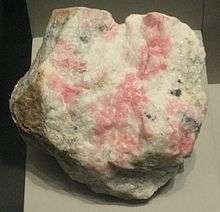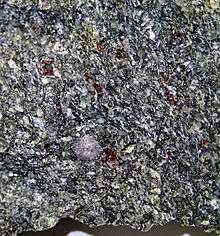Kvanefjeld
Kvanefjeld (or Kuannersuit), in Greenland, is the site of a mineral deposit, which is claimed to be the world's second-largest deposit of rare-earth oxides, and the sixth-largest deposit of uranium.[1] There are also substantial sodium fluoride deposits, and Kvanefjeld is thought to be one of the largest multi-element deposits of its kind in the world.[2]


Geology
The Kvanefjeld site is part of the Ilimaussaq intrusive complex.[3] Rare earths and uranium are typically concentrated in lujavrite.[4]
Lujavrite, a dark agpaitic nepheline syenite, occurs as an internal layer in the north Ilimaussaq complex. The uppermost sections generally have the highest rare-earth elements, uranium and zinc grades.
Lujavrite is a rare variety of nepheline syenite having amphibole, aegirine pyroxene, nepheline and feldspar. The red spots in the rock are crystals of the rare halide mineral villiaumite (NaF - sodium fluoride).
Kvanefjeld is already known among mineral collectors as a source of fluorescent minerals such as tugtupite and chkalovite.[5]
Exploration
The mineral deposit was first discovered in the 1950s. Much of the historical process development focused on uranium extraction, including a promotional visit by physicist Niels Bohr to the nearby town of Narsaq in 1957.[6] In 1983, the Danish government decided not to pursue the option of nuclear power, and work programs on Kvanefjeld ceased.
Greenland Minerals and Energy acquired the area in 2007.[7]
A 2010 relaxation of regulations by the government of Greenland opened up the possibility of large-scale mining.[8] A mining licence application to the Greenland government was submitted in 2015[9] for an open-pit mine.[10][11]
In 2017 the major shareholder of GME was Shenghe Resources Holding Co. Ltd, listed on the Shanghai Stock Exchange.[9]
References
| Wikimedia Commons has media related to Minerals of Kuannersuit plateau. |
- Bennet, Michael (2010-09-10). "Greenland Minerals poised to move on Kvanefjeld rare earths plan". The Australian. Retrieved 2010-09-13.
- "Greenland Minerals Ltd - Iimaussaq Complex – Specialty Metals (Kvanefjeld)". Retrieved 2018-04-05.
- "Greenland Minerals Ltd". Archived from the original on 2010-09-18. Retrieved 2010-09-13.
- "Kvanefjeld Uranium deposit, Kuannersuit (Kvanefjeld) plateau, Ilimaussaq complex, Narsaq, Kitaa (West Greenland) Province, Greenland". Retrieved 2010-09-13.
- "LUMINOUS TRAVELS: ILIMAUSSAQ, GREENLAND". Retrieved 2010-09-13.
- Walsh, Maurice (2 December 2017). "'You can't live in a museum': the battle for Greenland's uranium". The Guardian. Guardian News & Media Limited. Retrieved 15 February 2020.
the Kvanefjeld mine has its booster in Ib Laursen, the operations manager who has become the public face of the project. A Dane who has lived in Narsaq for over a decade, Laursen is promising 2,000 jobs during the construction of the mine and a new harbour, and a further 800 permanent jobs (300 for locals) over the next three decades.
- "Kvanefjeld – A project with a deep history". Retrieved 2018-04-05.
- "Mining Journal - Greenland amends law to allow uranium mining". Archived from the original on 2010-11-16. Retrieved 2018-04-05.
- "Greenland Minerals and Energy Ltd - 2017 Annual report" (PDF). Retrieved 2018-04-05.
- McGwin, Kevin (September 5, 2018). "A decade on, a Greenland rare-earths mine is close to final approval". Arctic Today. Alice Rogoff. Retrieved 15 February 2020.
- Cecilia, Jamasmie (March 13, 2017). "Greenland closer to building world's fifth-largest uranium mine". Mining Dot Com. Glacier Media Group. Retrieved 15 February 2020.
The proposed open pit mine in the southern town of Kvanefjeld is expected to process over 100 million tonnes of ore in the coming decades, helping Greenland to diversified its economy.